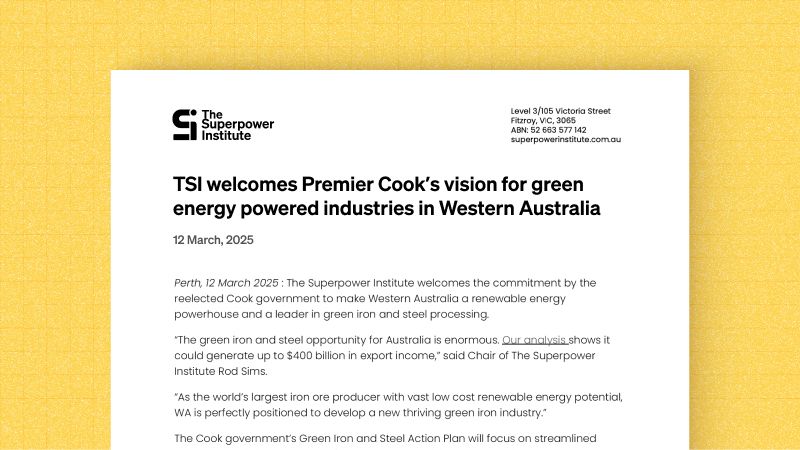Thank you to Informa for the invitation to be here today and to the excellent speakers on the program who have made it a great event.
My contribution will be a little bit different to most others, focusing on the policy aspects of realising green iron opportunities in Australia.
I’m going to cover three areas:
1. A bit of background about my organisation and why we have an interest here
2. The justification for the role of government and policy, including some relevant history and economics
3. Some specific policy ideas from TSI
So first, a bit about TSI.
We are a not-for-profit economic research and policy think tank, established by professors Ross Garnaut and Rod Sims. Our mission is to help Australia make a major contribution to global decarbonisation and, in doing so, build sustained economic prosperity in Australia.
This can be achieved by harnessing the power of what we call ‘superpower’ industries. These are industries in Australia where we enjoy a comparative advantage. The main sources of these comparative advantages are abundant availability of mineral resources and biomass and the capacity to produce large quantities of very low cost renewable energy.
In a zero carbon energy world, where transporting energy will be prohibitively costly, it will make sense to use energy close to where it is produced. Trade in energy will come in the form of energy embedded in processed goods.Green iron is the most prominent of these opportunities. Work we released late in 2024 showed that, at full scale, the opportunity can be worth up to $400 billion in export revenue and a reduction of 4% of global emissions.
As a philanthropically funded not-for-profit, TSI does not have a commercial interest in the development of this industry, but we exist to pursue the public interest Australia has in maximising its potential.
Turning now to some history.
It is not always obvious to people why policy has an important role in this space. Why not just let the market decide? If green iron is the answer, then the private sector will make it happen. Won’t it?
Economics has an answer to that question which I’ll return to shortly, but I think we can also learn from history. I think these examples demonstrate why there’s an important role for government in the development of new industries in certain situations.
In the 1800s, right here in Western Australia gold deposits were discovered around Coolgardie and Kalgoorlie. But there was a problem: a lack of water.
So in 1896, the then Premier, Sir John Forrest, engaged an engineer by the name of C Y O’Connor to design and build a pipeline to connect the goldfields of WA to water.
The task involved connecting the Mundaring Weir, near Perth to the location of the gold deposits nearly 500km away, by a steel pipeline supported by pumping stations.
So much doubt existed over the project that it was dubbed ‘Forrest’s folly’ by sceptics at the time.
Premier Forrest was not deterred. The project proceeded at a cost of £2.5 million (about half a billion dollars in today’s value) and was completed in 1903. The Goldfields Water Supply Scheme still operates to this day and is recognised as one of Australia’s greatest engineering achievements. By connecting the goldfields to a reliable water supply the gold industry thrived and transformed the state’s prosperity in the process.
A more recent example is that of the North West Shelf Venture of WA. The government’s role in the development of this gas field was again controversial, but no less pivotal.
The WA Government, led by Premier Charles Court, saw the potential in the new gas industry and saw fit to enter into take or pay agreements with the project proponents that underwrote the successful trade of gas with Japan and Korea. It was a hugely costly undertaking by the government, but one that was instrumental in the ultimate success of the project, and one that has contributed hundreds of millions of dollars of export revenue and jobs in this state.
The list of other examples of government involvement in early industry development is lengthy and includes building infrastructure like ports, railways, irrigation, electricity generation and transmission. It includes geological surveys and research into viable plant varieties for agriculture. And it includes providing government backed lending to farmers in the early stages of agricultural development in this country.
These examples demonstrate that foresight on the part of government and directing taxpayer dollars to the right kind of initiatives can have large long-term benefits for the economy and the community.
However, not all such government investment is soundly based. Economics gives us the tools to make sure there is an efficient use of public funds.
As I mentioned earlier, Australia has a comparative advantage in superpower industries like green iron, based on the abundance of raw materials we have and a capacity to produce very low-cost zero-carbon energy.
Comparative advantage is a necessary condition for government involvement. We should not invest in the development of industries where Australia has a comparative disadvantage and where we are better off importing from lower-cost producers.
The next point about economics is on the role of market failures. Returning to my rhetorical question earlier: if it’s a good idea why won’t the private sector make green iron happen? The answer is that there are profound market failures at play here.
They come in three forms:
First, there is a negative externality in the form of carbon emissions. Carbon emissions contribute to global warming, which reduces the welfare of the world’s inhabitants. Right now, polluters, including steelmakers operating blast furnaces, don’t pay for the full extent of that damage. Carbon prices are in place in some parts of the world, but in order to resolve this market failure, the majority of the world eventually needs to adopt carbon pricing.
In the absence of carbon pricing, governments can use second- and third-best policy solutions like production subsidies. I’ll return later to this topic.
The second market failure that exists relates to innovation. With any new technology, the first movers, the innovators, expose themselves to great costs and risk by investing in development and deployment of new technologies. When they do this, they benefit others who follow by generating knowledge about what works and what doesn’t.
Subsequent investors are able to optimise their investment decisions on the back of lessons that would not have been learnt if not for the early movers. In economics, we call this an innovation spillover. There is a role for government in rewarding early movers who produce knowledge that subsequent investors will benefit from.
The third type of market failure relates to the role of infrastructure and particularly common-user infrastructure. In some types of industries, where there is a reliance on large-scale, capital-intensive infrastructure, it will be extremely difficult or impossible for a single firm to raise the capital necessary to invest in such critical infrastructure.
Examples include things like roads, ports, railways, pipelines, energy transmission, and energy storage. In such situations, there is a role for government in contributing to capital costs of this infrastructure and committing to this ahead of demand. This can be critical to unlocking private sector investment which is reliant on it.
The fourth area I’ll mention is not what I would describe as a market failure but is nevertheless an important role for the right government policy: diplomacy and trade relations. James Choi covered this too in his contribution yesterday.
Diplomacy is important in two areas.
First, Australia’s superpower industries, like green iron, can only thrive in a world where other countries price carbon efficiently, and so our government should take actions to promote those settings internationally. This includes leading by example ourselves and adopting our own carbon pricing and then advocating for other countries to do the same.
Second, just as diplomacy and trade relations were instrumental in the development of other large export industries in Australia, so too will it be critical when it comes to superpower industries like green iron. In particular, the government has much work to do in convincing our trade partners that the best long-term solution for them is to outsource iron making to Australia.
Now, to conclude, having described some historical precedents and the general conditions where government has a role to play, let me talk about some specific policy ideas The Superpower Institute has for green iron. We will have more to say on this front in the coming months when we publish a major piece of work in this area.I should firstly acknowledge that significant progress has already been made under the Albanese government. I would specifically call out three things where credit is due.
The National Interest Framework, which prescribes the government’s approach to decisions about which industries to support, is an excellent piece of work. It adopts much of the comparative advantage and market failure framework I have described. Without this, Australia could wrongly go down the path of supporting making anything and everything here, much to our detriment.
Another important step has been legislating the hydrogen production credit of $2/kg. While this alone won’t be sufficient, and I’ll return to why shortly, it is going to be an important contributor to closing the green cost gap for iron.
The third thing is the $1bn green iron fund. While we await further detail on how this will be applied, this quantum of support is most welcome.
So, what more needs to happen? I’ll focus on three areas.
First, we would like to see the government’s support package for green iron to clearly describe the qualification criteria against which investors can easily assess their eligibility. The criteria should be based on the National Interest Framework.
Such eligibility should be self-determining. That is, if the criteria are met, a project qualifies. There needn’t be a role for the government in subjectively assessing whether a project makes the grade. This promotes certainty for investors and it ensures the right kind of projects are getting government support.
The second thing we would like to see is, as I mentioned earlier, efforts to promote the benefits of investment in Australian green iron with our trade partners. Benefits of securing low-cost, low-carbon iron from Australia will be realised in our trade partners’ economies, contributing hugely to their decarbonisation efforts and preserving the long-term competitiveness of their industries.
This means some contribution by the governments of our trade partners will be appropriate. The $2/kg hydrogen credit alone won’t bridge the gap between green production methods and fossil fuel based ones. The destination countries for green iron can help contribute to the remaining gap. We will have more specifics on this in our forthcoming work.
The third thing we have identified as important is somewhat novel. We see a role for government in helping to solve a very tricky coordination problem.Australia is a vast land mass which is both a blessing and a curse when it comes to energy production. The blessing is that the sun is shining and the wind is blowing pretty much always, somewhere. There are some places in Australia where the capacity factors for renewable energy are around 70%, some of the best in the world. The curse is that it is very costly to transport energy across long distances.
The challenge for green iron production is that the best locations for producing energy aren’t always nearby to locations where iron ore is, so it can be challenging to make the green iron manufacturing economics stack up.
This is not a new kind of problem. The renewable energy target, the RET, has operated as a certificate scheme for renewable energy in Australia where the benefits of producing renewable energy have been rewarded regardless of the location of the production source. We see merit in a similar approach to the production of renewable hydrogen in Australia. Stay tuned for more on this in our forthcoming work.
To sum up, TSI is here to work with industry and with government to overcome the barriers to realising superpower industry development in Australia. Policy can and will play a key role. History demonstrates how powerful this can be. To quote Premier Forrest in the glow of success of the Goldfields Water Supply Scheme:
"They said it could not be done. Well, we are doing it."
Thank you.
Baethan Mullen
Chief Executive Officer
Baethan Mullen has over 20 years of experience in public policy, economics and advocacy. Prior to joining the Superpower Institute, Baethan was General Manager of Economics & International at the ACCC, and led the largest energy efficiency program in Australia as Executive Director at the Essential Services Commission.
Baethan Mullen has over 20 years of experience in public policy, economics and advocacy. Prior to joining the Superpower Institute, Baethan was General Manager of Economics & International at the ACCC, and led the largest energy efficiency program in Australia as Executive Director at the Essential Services Commission.



